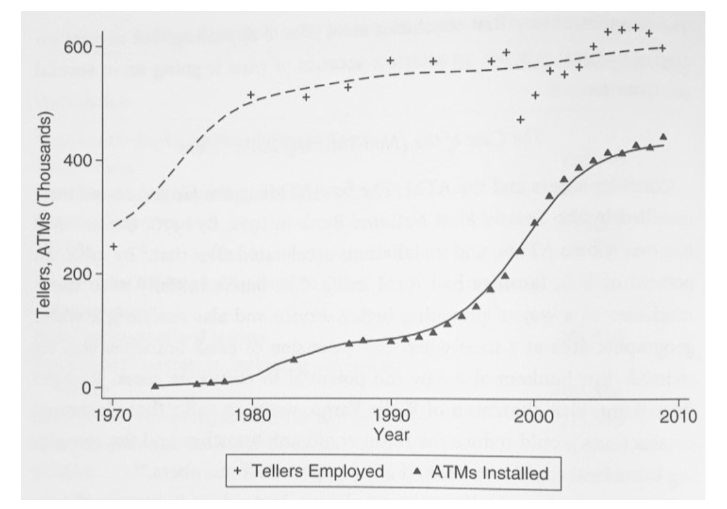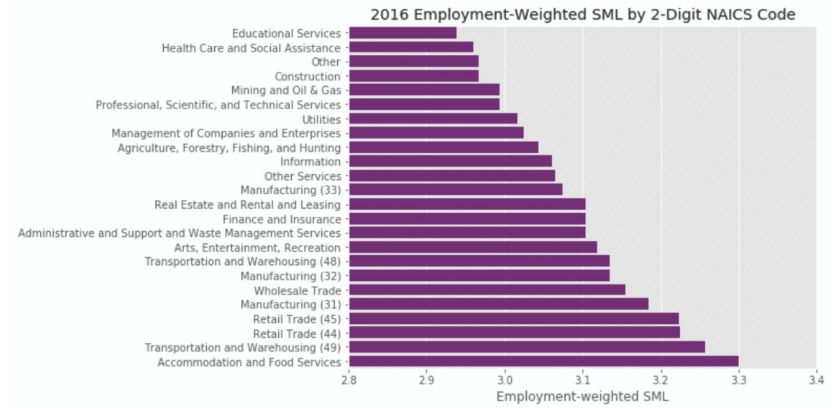Every few years, I review literature on productivity and automation. As a data scientist working in large enterprises, I have a front row seat to an emerging skillset that fits into our digital economy. As a former educator, I have a specific bias towards skill and capability development. These reviews are an attempt to understand some of the prevailing economic forces today, and identify the best next steps forward for creating opportunity for all. This article highlights the role of product or service demand in job loss and job reskilling.
Are robots taking our jobs? No - but the nature of work is changing.
There have been many reports of widespread job loss due to artificial intelligence, which are continually being refined and hedged back. Pew Research reported in 2018 that 65% of Americans believe most jobs will be lost in the next 50 years. An Oxford University study estimated that “47 percent of U.S. workers have a high probability of seeing their jobs automated over the next 20 years.” It was even a primary component of Andrew Yang’s presidential platform.
Experience and research would suggest that these projections are sensational, and divorced from the practical drivers associated with the change. For example, it’s important to have an accurate baseline for natural technological progress. In the decade between 2006 and 2016, over 51 million jobs were destroyed, while 179 million jobs were created. Should we highlight the -51 million number? Or the net +130 million number?
Additionally, automation is primarily a task-based endeavor - it does not create wholesale job loss, just parts of jobs. The associated process redesign that is required for people ot adopt new skills and tools acts both as a natural governor on the rate of change and suggests that the value created must be far in excess of the pain requirred to have folks change their jobs.
A third reason to question sensational headlines: automation changes the cost of production, which may have an effect on demand. It’s important to understand product or market elasticity before making assumptions about turnover or loss. What are consumer habits when a product or service is both cheaper and faster?
This all being said, it is important to have a perspective on the impact automation will have on your business. The opportunity afforded by machine learning and automation is material. Organizations need to prepare their workers for lifelong learning and have a vision for how to develop their workforce to manage the change. The following section walks through recent research on this topic and some of the policies, programs, and initiatives being established to support the change.
Understanding demand is a critical lever in understanding the rate of job turnover
Artificial intelligence (AI) technologies will automate many tasks, but the effect on employment is not obvious. For example, in manufacturing, technology has sharply reduced jobs in recent decades. But before that, for over a century, employment grew, even in industries experiencing rapid technological change. What changed? Demand was highly elastic at first and then became inelastic.
The effect of artificial intelligence on jobs will similarly depend critically on the nature of demand. New technologies do not just replace labor with machines, but, in a competitive market, automation will reduce prices. In addition, technology may improve product quality, customization or speed of delivery. All of these things can increase demand. If demand increases sufficiently, employment will grow even though the labor required per unit of output declines.
This relationship can be seen in the “Inverted U” diagram shown below. Although labor productivity in cotton textiles increased nearly 30-fold during the 19th century, consumption of cotton cloth increased 100-fold.

It is an empirical matter to determine whether industries have pent up demand — especially if they have seen relatively little automation to date — or an inelastic demand response. A more recent example involves the interaction between bank tellers and the introduction of the ATM.

With the introduction of the ATM, the average bank branch in an urban area was reduced from 21 tellers to 13 - making it cheaper to manage a branch. When it became cheaper to do so, demand for branch offices (and more bank tellers, but with a different mix of responsibilities) increased as well. As can be seen above, this was enough to offset the labor-saving losses of jobs that would have otherwise occurred.
Newly created (or modified) jobs will be different from those eliminated by automation
The challenge of automation in the near future will likely not be mass unemployment, but, instead, a greater level of worker transitions. These transitions may involve temporary unemployment spells and a loss of income. Automation thus places a burden on workers even if, in the end, they do not permanently lose employment. Moreover, inefficient transitions can slow the productivity-enhancing promise of new technology.
One can estimate the rate of job change and loss by focusing on what ML can do with respect to the tasks currently done by workers. To do this, economist Erik Brynjolfsson built a rubric to identify which tasks (and jobs) in the economy have the greatest “suitability for machine learning” (SML).

The fact that most occupations fall between these extremes underscores the likelihood that machine learning will drive re-organization and re-engineering of how tasks are bundled and assigned into occupations. Indeed, Brynjolfsson et al. (2019), highlight that re-organization of work, not automation or substitution, is the labor demand force with the greatest economic potential for ML. These changes are heterogenous by industry and may take decades to have the full effect migrate through the economy.
Even with the differences in the rate and nature of change associated with automation, it is important to acknowledge that a substantial portion of the workforce is now, and will continue to be, affected each year. Workers at these automating firms experience non-negligible income losses - in a study of the Netherlands market by James Bessen, this was estimated to be about 11% of a year’s pay on average. “There is a serious social challenge,” Bessen says. “Even in a place like the Netherlands that’s supposed to have a great social safety net—it’s not working.”
